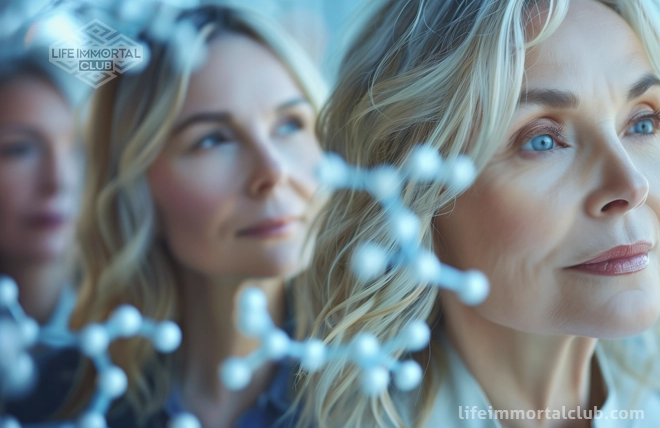
What Causes Aging? Simple Explanations of the Hallmarks of Aging
Aging is an inevitable part of the human experience, and its causes have long fascinated scientists and researchers. Over the years, extensive investigations have revealed a complex interplay of factors that contribute to the process of aging in humans.
These factors are collectively known as the hallmarks of aging, which provide valuable insights into the underlying mechanisms behind this natural phenomenon. One essential hallmark of aging is altered cellular communications.
As we age, our cells become less efficient in transmitting signals and coordinating with one another. This breakdown in communication can lead to various physiological dysfunctions, ultimately contributing to the overall decline associated with aging.
Understanding and intervening in these altered cellular communications hold promise for potential strategies to reverse aging in humans. Another significant hallmark is genomic instability, which refers to changes or mutations that occur within our DNA over time.
These mutations can accumulate due to various environmental factors such as exposure to harmful substances or even intrinsic metabolic processes within our bodies. Genomic instability plays a critical role in many age-related diseases and contributes significantly to the overall decline observed during aging.
Telomere shortening constitutes yet another important hallmark of aging. Telomeres are protective caps located at the ends of chromosomes that gradually shorten with each cell division throughout our lives.
This shortening acts as a biological clock, regulating cell replication until it reaches a point where cells can no longer divide effectively—a key factor leading to tissue dysfunction and age-related diseases. Understanding these three hallmarks - altered cellular communications, genomic instability, and telomere shortening - provides a fundamental framework for comprehending the multifaceted process of aging in humans.
Harnessing this knowledge allows scientists to explore potential interventions aimed at slowing down or reversing some aspects of aging by addressing these underlying causes. By unraveling and targeting these hallmarks, researchers strive towards improving not only human lifespan but also healthspan—the period during which we enjoy good health and vitality throughout our lives.
The 12 Hallmarks of Aging
The 12 Hallmarks of Aging Aging, a complex biological phenomenon, is governed by a multitude of factors that contribute to the gradual deterioration of physiological function and overall health in humans. Researchers have identified twelve distinct hallmarks that underlie the aging process, each playing a significant role in the progression of this natural phenomenon.
One key hallmark is altered cellular communications, which refers to the impaired intercellular signaling that occurs as we age. Cells rely on precise communication mechanisms to coordinate various processes within the body.
However, over time, these communication pathways become disrupted due to changes in gene expression and altered receptor activity. This leads to diminished cellular functionality and can result in tissue dysfunction and the onset of age-related diseases.
Another hallmark is genomic instability, which refers to the accumulation of DNA damage and mutations over time. Our genetic material is constantly exposed to various stressors such as radiation, toxins, and errors during replication.
As a consequence, errors can occur in our DNA sequence or structure, compromising its integrity. This instability contributes significantly to aging by impairing cell function and increasing susceptibility to diseases like cancer.
Telomere shortening is yet another crucial hallmark linked with aging in humans. Telomeres are protective caps at the ends of chromosomes that prevent them from fraying or sticking together.
Every time a cell divides, telomeres shorten until they reach a critical length where cells cease division or undergo senescence. This process limits cell proliferation potential and contributes to age-related cellular dysfunction.
Epigenetic alterations are also recognized as one of the hallmarks of aging. Epigenetics involves modifications that regulate gene expression without altering DNA sequences themselves.
These modifications can change over time due to environmental factors or natural processes associated with aging. Such alterations can lead to dysregulated gene expression patterns with detrimental effects on cellular function throughout our lifespan.
Loss of proteostasis is yet another fundamental hallmark associated with aging in humans. Proteostasis refers to the maintenance of proper protein folding and clearance within cells.
As we age, this delicate balance becomes disrupted, resulting in the accumulation of misfolded proteins that can form aggregates and impair cellular function. This hallmark is particularly relevant in neurodegenerative diseases such as Alzheimer's and Parkinson's, where protein aggregation plays a major role.
The hallmarks of aging encompass a wide range of biological processes that together contribute to the gradual decline in physiological function over time. Altered cellular communications, genomic instability, telomere shortening, epigenetic alterations, and loss of proteostasis are just a few examples of these intricate mechanisms underlying aging in humans.
Understanding these hallmarks is crucial for developing interventions aimed at mitigating their effects or even potentially reversing some aspects of aging. Harnessing the knowledge surrounding these hallmarks opens up exciting avenues for exploring innovative therapies that may help enhance healthy aging and improve quality of life for individuals as they grow older.
1. Altered Cellular Communications
Cellular communication plays a crucial role in maintaining the normal functioning and homeostasis of our bodies. However, with aging, this intricate network of signaling pathways becomes disrupted, leading to altered cellular communications.
This hallmark of aging encompasses various molecular changes that affect the transmission and reception of signals among cells. One significant factor contributing to altered cellular communications is the accumulation of damage to the DNA.
This can occur due to various factors such as environmental toxins, radiation exposure, or errors during DNA replication. As a result, mutations may arise in critical genes involved in cell signaling pathways, compromising their ability to transmit signals accurately.
Additionally, oxidative stress, which increases with age, can further exacerbate damage to DNA and interfere with cellular communication. Another aspect of altered cellular communications in aging is the dysregulation of intercellular signaling molecules such as hormones and growth factors.
These molecules are essential for coordinating various physiological processes within our bodies. However, as we age, there can be disruptions in their production or reception by target cells.
For instance, hormone levels may decrease or become imbalanced over time due to declining function of endocrine organs. Similarly, receptors on target cells may become less responsive or lose sensitivity to specific growth factors.
Moreover, chronic low-grade inflammation that occurs with aging (known as inflammaging) contributes significantly to altered cellular communications. Inflammatory molecules called cytokines can disrupt normal signaling pathways by interfering with receptor binding or downstream signaling cascades.
This chronic inflammation can result from various factors such as accumulated damage from reactive oxygen species (ROS), immune system dysfunction, or changes in the composition of gut microbiota. Altered cellular communications represent one crucial hallmark of aging in humans encompassing multiple mechanisms that disrupt signal transmission among cells.
Factors like DNA damage accumulation, dysregulation of intercellular signaling molecules like hormones and growth factors, and chronic inflammation all contribute towards this phenomenon. Understanding these underlying mechanisms is crucial for developing interventions aimed at maintaining or harnessing the nine hallmarks of aging, potentially leading to innovative strategies to reverse aging in humans and promote healthier and more vibrant lives.
2. Genomic Instability
Genomic instability is a key hallmark of aging in humans, contributing to the gradual decline in cellular and tissue function as our bodies grow older. This hallmark refers to the accumulation of genetic alterations, such as mutations, chromosomal rearrangements, and DNA damage. These genomic abnormalities can arise from a variety of sources, including environmental factors like radiation and chemicals, as well as endogenous processes such as errors during DNA replication or repair.
One prominent contributor to genomic instability is oxidative stress. Reactive oxygen species (ROS), byproducts of normal cellular metabolism, can cause damage to DNA molecules.
Over time, this accumulation of DNA damage can lead to mutations that disrupt the functioning of genes involved in critical cellular processes. Additionally, certain external factors can increase the risk of genomic instability.
For instance, exposure to ionizing radiation or carcinogens found in substances like tobacco smoke or certain industrial chemicals can significantly contribute to the development of genetic abnormalities. Moreover, deficiencies in DNA repair mechanisms that safeguard against mutations can also exacerbate genomic instability.
Understanding genomic instability and its role in aging has significant implications for research aiming to reverse aging in humans. By developing strategies that mitigate DNA damage and enhance DNA repair mechanisms, scientists may be able to slow down the progression of age-related diseases and extend healthspan.
Harnessing emerging technologies like gene editing or targeted therapies could potentially address genomic instabilities at their root causes and pave the way for innovative interventions that target this particular hallmark among the 12 hallmarks of aging. Genomic instability plays a crucial role in aging by compromising the integrity and functionality of our genetic material over time.
Factors such as oxidative stress and exposure to environmental toxins contribute significantly to these genetic alterations. However, ongoing research offers hope for potential interventions that could counteract genomic instability and potentially slow down age-related declines by targeting this specific hallmark among the 12 hallmarks of aging.
3. Telomere Shortening
Telomere shortening is one of the critical hallmarks of aging in humans. Telomeres are the protective caps at the ends of our chromosomes that gradually shorten each time a cell divides. Think of telomeres as the protective plastic tips on shoelaces that prevent them from unraveling.
Over time, as telomeres become shorter, they lose their ability to maintain chromosomal integrity and stability. This process is often referred to as "replicative senescence" or cellular aging.
Telomere shortening occurs because DNA replication machinery cannot fully duplicate the ends of linear chromosomes during each round of cell division. As a result, with each division, some portion of the telomere is lost until it reaches a critical threshold where it can no longer function effectively.
This progressive erosion eventually triggers cellular senescence or programmed cell death. Research has shown that telomere shortening plays a significant role in aging-related diseases and overall lifespan.
Individuals with shorter telomeres tend to have a higher risk for various age-related illnesses such as cardiovascular disease, diabetes, cancer, and even dementia. Additionally, studies have demonstrated a correlation between shortened telomeres and reduced longevity in humans.
While it may seem disheartening that telomeres naturally shorten over time, scientists are actively exploring ways to potentially reverse this process and slow down aging in humans by targeting telomere maintenance mechanisms. One approach under investigation involves activating an enzyme known as telomerase that can replenish or lengthen telomeres by adding back lost DNA sequences.
Although harnessing this strategy for therapeutic purposes is still in its early stages, it holds promising potential for promoting healthy aging and extending human lifespan. Telomere shortening represents one of the key mechanisms driving aging in humans.
As these protective caps erode over time due to repetitive cell divisions, chromosomal instability increases along with susceptibility to age-related diseases and decreased longevity. However, ongoing research into telomerase activation and other interventions may offer possibilities for reversing or slowing down this process, paving the way for future breakthroughs in anti-aging treatments and strategies.
4. Epigenetic Alterations
Epigenetic alterations, one of the key hallmarks of aging in humans, play a significant role in the aging process. Epigenetics refers to changes in gene expression patterns that occur without altering the underlying DNA sequence. These alterations can be influenced by various environmental factors, including diet, stress, and exposure to toxins.
Over time, these modifications accumulate and contribute to age-related changes in cellular function. One major epigenetic alteration associated with aging is DNA methylation.
Methylation involves the addition of a methyl group to specific regions of DNA, which can affect gene expression. As we age, global DNA methylation levels tend to decrease.
This reduction leads to changes in gene regulation and can impact various cellular processes involved in aging and disease development. Furthermore, histone modifications also undergo alterations during aging.
Histones are proteins that help package DNA into a compact structure called chromatin. Different modifications on histones can either activate or repress genes within the chromatin structure.
With age, there is evidence of increased histone deacetylation and reduced acetylation levels overall. These changes can result in less accessible chromatin and decreased transcriptional activity of certain genes involved in essential cellular processes.
In addition to DNA methylation and histone modifications, other epigenetic alterations such as microRNA dysregulation have been linked to aging processes. MicroRNAs are small RNA molecules that regulate gene expression by binding to messenger RNA (mRNA) molecules and preventing their translation into proteins.
Studies have shown that specific microRNAs exhibit altered expression patterns during aging, leading to disruptions in critical pathways involved in maintaining cellular homeostasis. Understanding these epigenetic alterations associated with aging opens up potential avenues for intervention strategies aimed at reversing or slowing down the aging process itself by targeting these molecular modifications.
By harnessing our knowledge about epigenetics and its role among the twelve hallmarks of aging, researchers hope to develop novel interventions that could potentially delay the onset of age-related diseases and promote healthier aging in humans. Overall, epigenetic alterations represent a crucial aspect of the complex biology underlying aging, offering exciting prospects for future anti-aging therapies.
5. Loss of Proteostasis
Loss of Proteostasis Within the complex and intricate process of aging in humans, one of the key hallmarks that emerges is the loss of proteostasis. This hallmark refers to the impairment in maintaining protein homeostasis, integrity, and functionality within cells as an individual ages.
Proteins are essential for cellular processes and play a crucial role in maintaining various physiological functions. However, with advancing age, the intricate balance between protein synthesis, folding, and degradation becomes disrupted.
Proteins undergo a delicate process of folding into their correct three-dimensional structure to function optimally. This folding process is tightly regulated by molecular chaperones ensuring proteins reach their functional conformation while preventing aggregation or misfolding events.
Unfortunately, during aging, this regulatory system becomes less efficient. The decline in chaperone activity leads to an accumulation of misfolded or damaged proteins within cells.
The accumulation of these aberrant proteins triggers several detrimental effects within cells and tissues. First and foremost, it disrupts cellular functions by impairing signaling pathways crucial for normal cell behavior.
Moreover, these aggregated proteins can form toxic aggregates that interfere with vital cellular processes such as metabolism or DNA repair. Ultimately, this loss of proteostasis contributes to the overall decline in cellular function seen during aging.
Efforts have been made to understand how we can harness the nine hallmarks of aging to reverse ageing in humans, including addressing the issue of proteostasis dysregulation. Researchers have discovered potential strategies to enhance proteostasis maintenance through interventions such as caloric restriction or pharmacological compounds targeting specific pathways involved in protein quality control mechanisms.
Loss of proteostasis emerges as a prominent hallmark of aging in humans. The disruption in protein homeostasis leads to detrimental consequences at both cellular and organismal levels.
Understanding the underlying mechanisms driving this hallmark is crucial for developing interventions that could mitigate age-related declines and potentially reverse certain aspects of aging. Further research is needed to elucidate the intricate pathways involved in proteostasis regulation and identify effective strategies to restore protein homeostasis during aging.
6. Cellular Senescence
Cellular senescence is one of the key hallmarks of aging in humans. It refers to the permanent state of growth arrest that cells enter into as they age or in response to various stressors. This phenomenon plays a crucial role in maintaining tissue homeostasis and preventing the proliferation of damaged or potentially cancerous cells.
However, as we age, an accumulation of senescent cells can have detrimental effects on our overall health. The process of cellular senescence is regulated by a complex interplay between numerous factors, including telomere shortening, DNA damage, oxidative stress, and inflammatory signaling pathways.
Telomeres are protective structures located at the ends of chromosomes that gradually shorten with each cell division. Eventually, this telomere attrition triggers cellular senescence as a safeguard against uncontrolled growth and genomic instability.
Senescent cells secrete a range of molecules known as the senescence-associated secretory phenotype (SASP). The SASP includes various pro-inflammatory cytokines, growth factors, and proteases that contribute to chronic low-grade inflammation – a condition known as inflammaging.
Inflammaging has been linked to various age-related diseases such as cardiovascular disease, neurodegenerative disorders, and cancer. Understanding cellular senescence opens up new avenues for potential interventions to promote healthy aging and reverse certain aspects of aging in humans.
Researchers are exploring strategies to selectively eliminate senescent cells through targeted therapies called senolytics. By removing these "senescent" cells from our bodies, it may be possible to mitigate some age-related diseases and improve overall healthspan.
Cellular senescence is an essential aspect of aging in humans that functions initially as a protective mechanism against uncontrolled cell growth but can become detrimental when accumulated over time. The intricate interplay between telomere shortening and other factors leads to the formation of senescent cells which secrete pro-inflammatory molecules.
These molecules contribute to chronic inflammation and various age-related diseases. Exploring ways to target and eliminate senescent cells could lead to novel interventions that promote healthy aging and potentially reverse some aspects of the aging process.
7. Mitochondrial Dysfunction
Mitochondrial Dysfunction: Mitochondria, often referred to as the powerhouses of our cells, play a crucial role in energy production and various metabolic processes. However, with aging, these vital cellular organelles begin to malfunction, leading to mitochondrial dysfunction.
This hallmark of aging has far-reaching consequences on overall cellular health and significantly contributes to the aging process in humans. One primary factor behind mitochondrial dysfunction is the accumulation of mitochondrial DNA (mtDNA) mutations over time.
These mutations can impair the electron transport chain's efficiency within mitochondria, leading to reduced ATP production and increased production of harmful reactive oxygen species (ROS). Consequently, this oxidative stress damages cell components such as proteins, lipids, and DNA itself.
Furthermore, impaired mitochondrial function also disrupts cellular signaling pathways involved in energy metabolism and nutrient sensing. Mitochondrial dysfunction affects not only energy production but also compromises other critical functions like calcium homeostasis and apoptosis regulation.
Dysregulated calcium levels can lead to neuronal damage and contribute to neurodegenerative diseases associated with aging. Research suggests that lifestyle factors such as a sedentary lifestyle or an unhealthy diet rich in processed foods can exacerbate mitochondrial dysfunction.
Conversely, regular exercise has been shown to positively impact mitochondrial health by promoting biogenesis (the creation of new mitochondria) and enhancing their functional capacity. Mitochondrial dysfunction represents a significant hallmark of aging in humans.
Understanding the underlying mechanisms contributing to this phenomenon is crucial for devising strategies aimed at delaying or mitigating age-related decline. Harnessing the potential of emerging technologies like gene therapy or targeted pharmaceutical interventions may provide promising avenues for addressing mitochondrial dysfunction and reversing some aspects of aging in humans.
8. Deregulated Nutrient Sensing
Deregulated Nutrient Sensing: One of the key factors contributing to the aging process in humans is deregulated nutrient sensing. Our bodies rely on a delicate balance of nutrients to function optimally, and any disruption in this balance can have profound effects on our health and longevity.
Nutrient sensing refers to the mechanisms by which our cells detect and respond to changes in nutrient availability, ultimately influencing various physiological processes. Aging is marked by a decline in the ability of our cells to efficiently sense and respond to nutrients.
This deregulation can lead to dysregulated energy metabolism, impaired cellular signaling pathways, and increased susceptibility to age-related diseases. One critical pathway involved in nutrient sensing is the mammalian target of rapamycin (mTOR) pathway.
mTOR functions as a central coordinator of cellular metabolism, growth, and proliferation in response to nutrient availability. However, with age, this pathway becomes less responsive to nutrient cues, resulting in decreased cellular functions and increased vulnerability.
Moreover, another aspect of deregulated nutrient sensing that contributes to aging is disrupted insulin signaling. Insulin plays a crucial role in regulating glucose metabolism and maintaining energy homeostasis within cells.
As we age, insulin sensitivity decreases due to impaired signaling cascades that normally respond to changes in blood glucose levels. This insulin resistance not only affects glucose regulation but also has widespread consequences on other vital metabolic processes such as lipid metabolism and protein synthesis.
To combat the detrimental effects of deregulated nutrient sensing on aging in humans, extensive research is being conducted with the aim of harnessing the nine hallmarks of aging identified by scientists. Strategies involving caloric restriction or dietary interventions have shown promising results by enhancing nutrient sensing pathways such as mTOR signaling or restoring insulin sensitivity.
Additionally, targeted pharmaceutical interventions that modulate these pathways are being explored as potential approaches for reversing aging or delaying age-related diseases. Deregulated nutrient sensing represents an important hallmark of aging in humans that significantly affects cellular functions and overall health.
Understanding the intricate mechanisms involved in nutrient sensing and the underlying molecular pathways is crucial for developing effective strategies to reverse aging or delay its onset. By restoring proper nutrient sensing, we may unlock the potential to enhance human longevity and improve quality of life as we age.
9. Stem Cell Exhaustion
Stem Cell Exhaustion: Stem cells play a crucial role in the maintenance, repair, and regeneration of tissues throughout our lives.
These remarkable cells possess the unique ability to self-renew and differentiate into various specialized cell types, thus replenishing damaged or aging tissue. However, as we age, the regenerative capacity of stem cells diminishes due to a phenomenon known as stem cell exhaustion.
One primary cause of stem cell exhaustion is telomere shortening. Telomeres are protective caps located at the ends of chromosomes that prevent DNA damage and maintain chromosomal stability.
With each round of cell division, telomeres gradually shorten until they reach a critical length, triggering cellular senescence or programmed cell death. This gradual erosion of telomeres limits the replicative potential of stem cells and ultimately leads to their functional decline.
In addition to telomere shortening, other factors contribute to stem cell exhaustion in aging individuals. Accumulation of DNA damage over time results in genomic instability within stem cells, compromising their ability to divide and differentiate effectively.
Moreover, epigenetic alterations can disrupt gene expression patterns necessary for proper stem cell function. These changes can cause stem cells to lose their regenerative abilities or become differentiated prematurely.
While it may seem discouraging that our reservoirs of rejuvenating stem cells decline with age, researchers have been exploring strategies to counteract this decline and harness the potential for reversing aging in humans. One promising approach involves activating dormant or quiescent adult stem cells through targeted interventions such as gene therapies or pharmacological agents that restore their regenerative properties.
By awakening these dormant reserves within our bodies, it may be possible to replenish depleted tissue reservoirs and promote overall rejuvenation. The depletion of stem cell populations due to telomere shortening and other factors contributes significantly to the aging process in humans.The loss of regenerative capacity hampers tissue repair and regeneration essential for maintaining youthful vitality.
However, ongoing research into stem cell biology offers hope for manipulating and reversing the effects of stem cell exhaustion. By understanding the intricate mechanisms underlying this hallmark of aging, we can strive towards developing innovative interventions that harness the regenerative potential of stem cells, ultimately paving the way for effective anti-aging therapies in the future.
10. Disabled Autophagy
Disabled Autophagy: One of the key processes involved in the aging of human cells is autophagy, a highly regulated mechanism responsible for degrading and recycling damaged or dysfunctional cellular components.
Autophagy plays a crucial role in maintaining cellular homeostasis and preventing the accumulation of toxic substances within cells. However, as we age, autophagy becomes impaired, leading to an imbalance between protein synthesis and degradation.
This impairment contributes significantly to the progression of aging. Autophagic dysfunction results from a combination of factors, including reduced autophagic flux, impaired lysosome function, and alterations in signaling pathways that regulate autophagy.
The decline in autophagic activity has been observed in various tissues throughout the body with aging. Accumulation of damaged proteins and organelles due to impaired autophagy can lead to cellular dysfunction and ultimately contribute to age-related diseases.
Researchers are actively investigating ways to modulate autophagy as a means to delay or reverse aging in humans. Several studies have shown that interventions such as caloric restriction and exercise can enhance autophagic activity.
Additionally, pharmaceutical interventions targeting specific molecular pathways involved in autophagy regulation are being explored as potential strategies for promoting healthy aging. Understanding the mechanisms behind disabled autophagy is essential not only for unraveling the complex process of aging but also for developing effective strategies to promote healthy aging.
Further research into identifying key regulatory factors within the autophagic pathway holds promise for potential therapeutic interventions that may harness this hallmark of aging. By restoring proper functioning of autophagy, it could be possible to mitigate age-related declines in cellular health and extend human lifespan.
Disabled autophagy is one of the hallmarks of aging that contributes significantly to cellular decline during the natural process of getting older. The impairment of this vital mechanism leads to an accumulation of damaged proteins and organelles within cells, resulting in cellular dysfunction and an increased risk for age-related diseases.
Researchers are actively exploring interventions that can enhance autophagy and promote healthy aging, ranging from lifestyle modifications to targeted pharmaceutical approaches. Advancements in this field hold the potential to unlock new strategies for combating the negative effects of aging and promoting overall well-being in humans.
11. Inflammaging
Inflammaging, one of the hallmarks of aging, refers to chronic low-grade inflammation that occurs as individuals grow older. This phenomenon is characterized by an increased production of pro-inflammatory molecules and a dysregulation of the immune system. Inflammaging plays a significant role in the aging process and is associated with various age-related diseases such as cardiovascular disease, diabetes, neurodegenerative disorders, and even certain types of cancer.
The underlying mechanisms behind inflammaging involve a complex interplay between immune cells, genetic factors, and environmental influences. As we age, our immune system undergoes changes that result in a state of chronic inflammation.
This state is perpetuated by various factors such as cellular damage due to oxidative stress, accumulation of senescent cells (cells that have lost their ability to divide), and alterations in the gut microbiome composition. These factors contribute to an imbalance in the production and regulation of pro-inflammatory cytokines.
Inflammaging not only affects systemic health but also has detrimental effects on specific organs and tissues. For instance, chronic inflammation in the brain can lead to neuroinflammation and cognitive decline seen in conditions like Alzheimer's disease.
In addition, inflammation within blood vessels can promote atherosclerosis (the buildup of plaque), increasing the risk of heart disease and stroke. Understanding the mechanisms involved in inflammaging is crucial for developing interventions that target this hallmark of aging.
Efforts are underway to identify potential therapeutic strategies that may counteract inflammaging. Researchers are investigating compounds with anti-inflammatory properties derived from natural sources such as plants or marine organisms.
Additionally, lifestyle modifications including regular exercise, healthy eating habits rich in antioxidants and anti-inflammatory nutrients (e.g., omega-3 fatty acids), stress reduction techniques like meditation or mindfulness practices may help mitigate chronic inflammation associated with aging. Inflammaging exhibits its impact on various aspects of human health during aging by contributing to age-related diseases and impairing organ function.
Finding ways to regulate and counteract chronic inflammation is a promising avenue for promoting healthier aging. Further research into the mechanisms behind inflammaging and the development of targeted interventions may pave the way for interventions that could potentially slow down or reverse aspects of aging in humans.
12. Microbiome Dysbiosis
The intricate relationship between the human body and the trillions of microbes that reside within it is a fascinating realm of scientific exploration.
The human microbiome, consisting of bacteria, fungi, viruses, and other microorganisms, plays a crucial role in maintaining our overall health and well-being. However, as we age, this delicate balance can be disrupted, leading to a condition known as microbiome dysbiosis.
Microbiome dysbiosis refers to an imbalance or alteration in the composition of the microbial communities that inhabit various parts of our bodies. This perturbation can occur in multiple areas such as the skin, mouth, gut, and even reproductive organs.
Age-related changes can affect the diversity and abundance of these microbial populations, potentially contributing to several aspects of aging. One key consequence of microbiome dysbiosis is its impact on immune function.
The aging immune system undergoes various alterations that impair its ability to mount effective responses against pathogens and maintain proper surveillance against abnormal cells. Disruptions in the microbiome further exacerbate these age-related changes by affecting immune cell development and function.
Moreover, dysbiosis can lead to chronic low-grade inflammation within the body—a condition known as inflammaging—which is closely linked with many age-related diseases. The potential for harnessing the power of microbes to reverse aging in humans has gained significant attention recently.
Researchers are exploring innovative strategies such as fecal microbiota transplants (FMT) to restore a healthy balance in older individuals' gut microbiomes. By introducing diverse microbial communities into their intestines through FMT procedures, they aim to mitigate age-associated inflammation and improve overall health outcomes.
Understanding how microbiome dysbiosis influences aging processes is an area ripe for further investigation. By unraveling these complex interactions between host physiology and microbial communities across different body sites through advanced sequencing techniques and computational modeling approaches, researchers hope to develop targeted interventions that restore balance to the microbiome and potentially slow down the aging process.
Microbiome dysbiosis represents an important piece of the puzzle when it comes to understanding age-related changes in our bodies. The delicate balance between a healthy microbial community and dysbiosis can significantly impact immune function, inflammation, and overall health as we age.
Exploring innovative interventions to restore this balance holds promise for improving health outcomes and potentially reversing some aspects of aging. As research in this field continues to expand, we may uncover novel strategies to harness the power of the microbiome in promoting healthy aging and extending human longevity.
Conclusion
The complex process of aging in humans is influenced by a multitude of factors that contribute to the gradual decline and deterioration of our bodies. The 12 hallmarks of aging discussed in this article shed light on the intricate mechanisms at play, providing a deeper understanding of why we age. One key aspect that emerges from this discussion is the role of telomere shortening.
Telomeres, protective caps at the ends of our chromosomes, naturally shorten with each cell division. Ultimately, this leads to cellular senescence and limits our cells' ability to replicate effectively.
However, recent research has shown promising results in telomere lengthening therapies that could potentially reverse aging in humans. While still experimental, these interventions offer hope for combating one of the primary causes of aging.
Moreover, harnessing the nine other hallmarks of aging can also prove pivotal in promoting healthy longevity. Understanding and targeting factors such as genomic instability, epigenetic alterations, proteostasis loss, mitochondrial dysfunction, nutrient sensing deregulation, stem cell exhaustion, disabled autophagy, inflammaging and microbiome dysbiosis can help develop preventive strategies against age-related diseases and promote overall well-being.
In an era where scientific advancements are rapidly reshaping our understanding of human physiology and expanding possibilities for medical interventions, there is reason to be optimistic about the future. While we cannot halt or reverse aging entirely yet, ongoing research into these hallmarks opens up exciting avenues for potential interventions that may delay age-related decline and empower individuals to lead more vibrant lives as they grow older.
: Aging is a natural part of life's journey but comprehending its underlying causes provides invaluable insights into potential strategies for healthy aging. With increasing knowledge about the 12 hallmarks of aging and ongoing scientific progress aiming to harness these mechanisms effectively while exploring new frontiers such as telomere lengthening therapies or other targeted interventions against specific hallmarks - we stand poised on the precipice of a future where aging is not merely a process to endure, but one we can confront and embrace with vitality.
Quick Definitions Of Human Aging Terms
This term is associated with the study of intercellular communication, a biological telecoms network which forms the basis for the coordination of various physiological functions within a multicellular organism².
This term is often associated with cancer research, particularly in relation to chromosomal instability (CIN), a continuous state of mitotic dysfunction that gives rise to karyotypic abnormalities⁵.
This term is recognized as one of the best biomarkers of aging, with research indicating that it is associated with age-related diseases, including Alzheimer’s disease⁸.
This term is linked to changes in gene activity and expression, and has been recognized as playing a crucial role in several human diseases¹³.
This term refers to the failure of protein building machinery of the cell and the accumulation of misfolded proteins, which is one of the root causes of age-related diseases¹⁶.
This term refers to a state comprising an essentially irreversible proliferative arrest combined with phenotypic changes and pronounced secretory activity²¹.
This term is associated with changes in mitochondrial respiratory chain with reduced ATP production and elevated reactive oxygen species production²⁴.
This term refers to the breakdown of the networks that regulate cellular activity, including autophagy, protein synthesis, metabolism, and the formation of mitochondria²⁹
This term refers to a decline in stem cell numbers and renewal capacity, which can lead to various health issues such as frailty and a weakened immune system³³
This term refers to an intracellular scavenging mechanism induced to eliminate damaged, denatured, or senescent macromolecular substances and organelles in the body³⁸.







